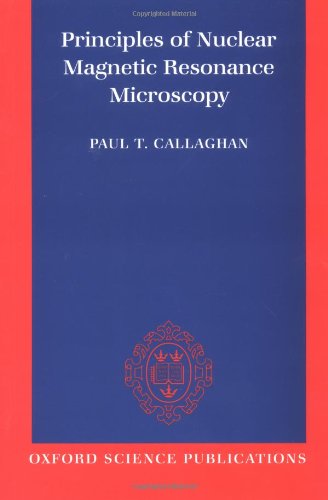Principles of Nuclear Magnetic Resonance Microscopy pdf download
Par mccrory john le mercredi, juin 22 2016, 03:12 - Lien permanent
Principles of Nuclear Magnetic Resonance Microscopy by Paul Callaghan


Principles of Nuclear Magnetic Resonance Microscopy Paul Callaghan ebook
ISBN: 0198539444, 9780198539445
Page: 512
Publisher: Oxford University Press, USA
Format: djvu
Magnetic resonance imaging (MRI) is based on the principles of nuclear magnetic resonance (NMR), which is a technique used to acquire chemical, physical, and microscopic information about molecules. The basis of NMR The principle behind NMR is that many nuclei have spin and all nuclei are electrically charged. Principles of Nuclear Magnetic Resonance MicroscopyPaul Callaghan; Oxford University Press, USA 1994. Many have taken an X-ray, CT scan or MRI at a hospital to diagnose a broken leg, but the same principle can be used to get a close-up view of individual molecules. This era saw a step change in his research productivity and impact, culminating in his first book, 'Principles of Nuclear Magnetic Resonance Microscopy' in 1994. Optical-atomic magnetometers are based on a different principle – one that, curiously, is something like NMR in reverse, except that optical-atomic magnetometers measure whole atoms, not just nuclei. NMR Imaging and Its Application to Clinical MedicineThe idea of using a magnetic gradient to introduce spatial information into signals from an NMR spectrometer, which can then be converted to an actu… Hébergé par OverBlog. 4Center for Magnetic Resonance Research, Department of Radiology, University of Minnesota Medical School, 2021 Sixth Street SE, Minneapolis, MN 55455, USA 5Department of Electrical and Computer Engineering, University of Minnesota, 200 Union Street SE, P. This work, focusing on cell metabolism, led Damadian to believe that there should be a way to detect cancerous cells through chemical analysis rather than by relying on direct visualization under a microscope. Nuclear Magnetic Resonance (NMR) spectroscopy, microscopy and imaging techniques (MRI) play a crucial role in numerous fields of science ranging from physics, chemistry, material sciences, biology to medicine. The high information content of modern multi-dimensional Although the hyperpolarization strategies differ in their underlying physico-chemical principles they have a number of problems in common. An NMR spectrometer works similarly to an MRI, but on a microscopic level. Experimental probes: X-ray scattering, neutron scattering, NMR, thermodynamic, transport. �An MRI places the whole organism in the magnetic field. Texas A&M University's Department of Biochemistry and Biophysics received a Nuclear Magnetic Resonance spectrometer that will expand macromolecular research. States of Matter, Phase Transitions, Critical Points. Callaghan, Principles of Nuclear Magnetic Resonance Microscopy, Clarendon, Oxford, UK, 1991.